
| Return |
| • August 26 I have been to Kochi Prefectural Folklore Historical Museum, where, I was told, they had been running an exhibition on goblins and ghosts throughout this summer. The museum is located at Oko in the City of Nangoku where stood the castle of Chosogabe Ganshin who controlled the island of Shikoku during the warring period among the feudal lords. The place is now designated as a historical site. Until I entered the hall I had suspected it would be just a dubious display of ghosts. However, I made unexpected "astronomical discoveries". One of them was a small astronomical armillary built by an unknown builder in ancient times. There was also a notebook which commemorated the apparition of a comet as early as 1000 years ago. A few planispheres were on display which may have been used for astrological purposes. These items have nothing to do with goblins but seem to be tools used by fortune tellers who had worked for the emperors until around the 14th century. These fortune tellers were government's formal officials and are said to have predicted the emperor's and nation's fortune using eclipses and appearances of comets and mysterious stars. Were these people employed later by the Shogunate as official astronomers? In the corner of the hall I found a very unusual thing looking like a stuffed "kappa (an imaginary river goblin)". I wondered if it was just a dummy. Kappa and Shibaten are a kind of goblins which lived in Tosa in ancient times. Here is a famous story about Kappa. Around 1950 Mr. S, a former head of OAA Kochi branch, was said to have walked along Shinjo River in Suzaki City up to the mountains seeking Kappa. He staked out there for three days and finally found one. He (a fourth-dan black-belt judo expert) struggled with it squarely, then....This Mr. S, after quitting astronomy, set out on his journey to explore the ocean floors looking for treasures left by pirates a long time ago. A huge submarine built by him is displayed in the courtyard of Ryoma Memorial Museum at Katsurahama. Twenty years later, Mr. S called me when he was about to leave a Kagoshima port for the South China Sea. His voice full of pride is still ringing in my ears, though it was the last time I had heard from him. |
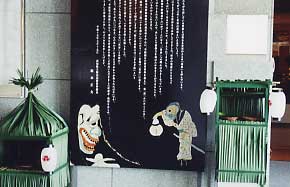 At the entrance of the goblins and ghosts exhibition 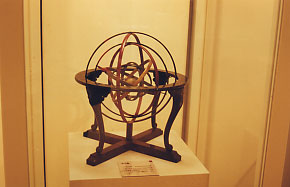 Japan's oldest armillary sphere 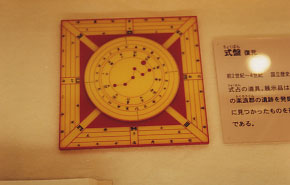 A replica of a star-board called Chokuban used for fortune telling (2-4th century) 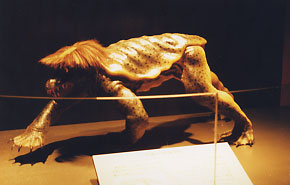 A replica of a Kappa believed to have lived on the shore of a river in Tosa |
| • August 23 Geisei Observatory's dome has developed some problem and substantial repair work is being made by Kuroki Construction Company from Tokyo. It will be completed on August 26. The 60cm telescope is now working with a slower slewing speed. The photograph was taken from the rooftop of my home looking northeast. In the distance the donjon of Kochi Castle is visible. The building under construction in the forefront is a museum dedicated to Ryoma Sakamoto (Asteroid 2835 is named after him)who lived during the days of Yamanouchi Yodo. It is to be completed in October. Ryoma's birthplace is found about 150 meters from the Castle and only 3 minutes' walk from my place, situated along a straight line drawn between Kochi Castle and my home. |
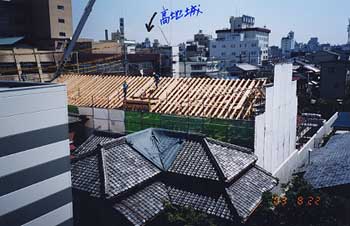 |
| • August 21 A long spell of rainy days had continued until quite recently. And at last we now feel the rainy season is over. Scorching summer days are continuing. Mars is much brighter and hanging in the mid-night southern sky. Mr. Kenji Muraoka dropped in with Mr. Kenichi Kadota, for Mr. Kadota has returned to the family home or something. It is very enjoyable to talk with Mr. Muraoka, who is always positive about observing and full of vitality. Mr. Muraoka, I was told, had been to Egypt with his son recently and seemed to be still suffering from a jetlag. A lot of good observing nights under good weather are in store for us. Let's look forward to them and achieve good results. |
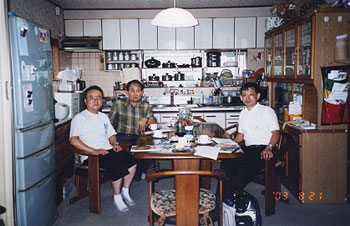 From let Kenji Muraoka , Seki, and Kenichi Kadota |
| • August 18 Since Typhoon No.10 crossed the shoreline, the weather has been unsettling. Mars rises early these days and is easy for the general public to observe. Mars is seen opposite to Fomalhaut in the constellation of Piscis Austrinus along the north-south line showing a beautiful red-blue color contrast. A public viewing day will be held on August 27 at Geisei Observatory. |
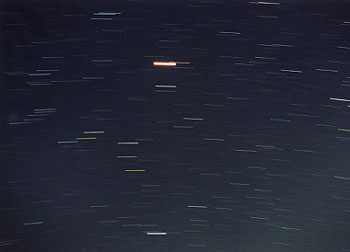 Mars 23.30 on August 10 50mm f/2.8 lens with a 5-minute exposure Geisei Observatory |
Copyright (C) 2003 Tsutomu Seki.